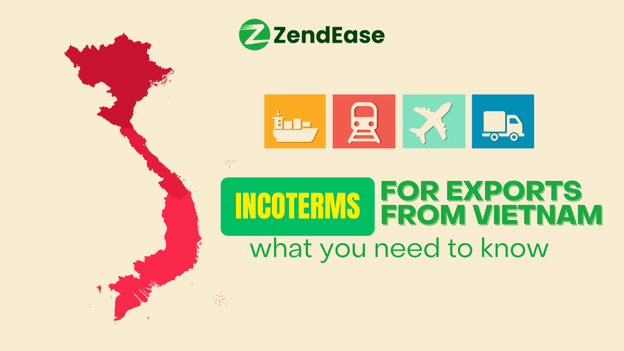Incoterms Explained: Which One to Use When Exporting from Vietnam
by Ly Nguyen on Sep 25, 2025

Exporting from Vietnam requires more than just securing international buyers. It also involves making strategic choices about how goods will move across borders. One of the most important decisions exporters face is selecting the right Incoterm (International Commercial Term). Incoterms define the responsibilities of buyers and sellers in terms of transportation, insurance, customs clearance, and the transfer of risk.
The right Incoterm can prevent hidden costs, avoid disputes, and strengthen long-term trade relationships. For many Vietnamese exporters, especially small and medium-sized enterprises, understanding Incoterms is not just a compliance issue but a way to gain a competitive advantage.
Common Incoterms for Vietnam Exports
Incoterms (International Commercial Terms) are a set of international trade rules that clearly define the responsibilities, costs, and risk transfer points between sellers and buyers in the delivery of goods. The latest version is Incoterms 2020 (with Incoterms 2025 expected to update but maintain the same role).
Below are the main groups of Incoterms commonly applied in Vietnam exports:
Group E – Departure
- EXW (Ex Works): The seller makes goods available at their premises or another named place (factory, warehouse, etc.). From that point, the buyer assumes all costs and risks, including loading, export clearance, and transport. Best suited when the buyer has a strong logistics capacity in Vietnam.
Group F – Main Carriage Unpaid
- FCA (Free Carrier): The seller delivers the goods to a carrier or another party nominated by the buyer at an agreed place. Risk transfers to the buyer once delivery is made.
- FAS (Free Alongside Ship): The seller delivers the goods alongside the vessel at the named port of shipment. The buyer takes responsibility once the goods are alongside the ship.
- FOB (Free On Board): The seller delivers when the goods are loaded on board the vessel at the port of shipment in Vietnam. The buyer assumes risk and costs from that point forward. FOB is widely used in Vietnam for exports such as seafood, textiles, and furniture.
Group C – Main Carriage Paid
- CFR (Cost and Freight): The seller pays the cost of transporting goods to the named port of destination, but the risk transfers once goods are loaded on the vessel.
- CIF (Cost, Insurance and Freight): Similar to CFR, but the seller also pays for minimum insurance coverage up to the destination port. This is often chosen for fragile or higher-value shipments.
- CPT (Carriage Paid To): The seller pays for transport to the agreed destination, but risk transfers once the goods are handed to the first carrier.
- CIP (Carriage and Insurance Paid To): The seller covers transport and insurance to the named place of destination. Risk, however, transfers upon delivery to the first carrier.
Group D – Arrival
- DPU (Delivered at Place Unloaded): The seller delivers and unloads the goods at the named place of destination. Risk transfers once unloading is complete.
- DAP (Delivered at Place): The seller delivers goods ready for unloading at the named place of destination. The buyer handles import clearance and duties.
- DDP (Delivered Duty Paid): The seller assumes all costs and risks—including transport, insurance, and import clearance—until the goods are delivered to the buyer’s premises or another agreed location.
Factors to Consider When Choosing an Incoterm
- Logistics Capacity: Determine whether the seller or buyer is better positioned to handle freight forwarding, customs, and insurance.
- Product Type: Fragile, perishable, or high-value goods often require seller-managed transport for safety and reliability.
- Cost Allocation: Clearly outline which party covers freight, insurance, and customs duties to avoid disputes.
- Risk Tolerance: Buyers with low tolerance for risk often prefer CIF or DAP, while sellers who wish to minimize exposure may favor EXW or FOB.
- Industry Practice: In some sectors, certain Incoterms are standard. For example, FOB is prevalent in textiles, while CIF is common in the electronics trade.
Why the Right Choice Matters
Selecting an Incoterm is more than a matter of contract language. It directly influences profitability, delivery performance, and the strength of business relationships. For Vietnamese exporters, the choice can shape:
- Profit margins - through the control of shipping and insurance costs.
- Delivery reliability - ensuring goods arrive safely and on time.
- Buyer relationships - by setting clear expectations and reducing disputes.
By carefully evaluating logistics capacity, product type, costs, and risks, exporters from Vietnam can position themselves more effectively in global trade. The right Incoterm not only streamlines operations but also builds trust and long-term partnerships.
Need Expert Support?
Choosing the right Incoterm can make or break your export deal. If you are preparing to ship from Vietnam and want professional guidance on reducing costs, minimizing risks, and ensuring compliance, ZendEase is here to support you.
Contact ZendEase today to get tailored advice on export logistics and international trade strategy, so you can expand with confidence and build stronger partnerships worldwide.